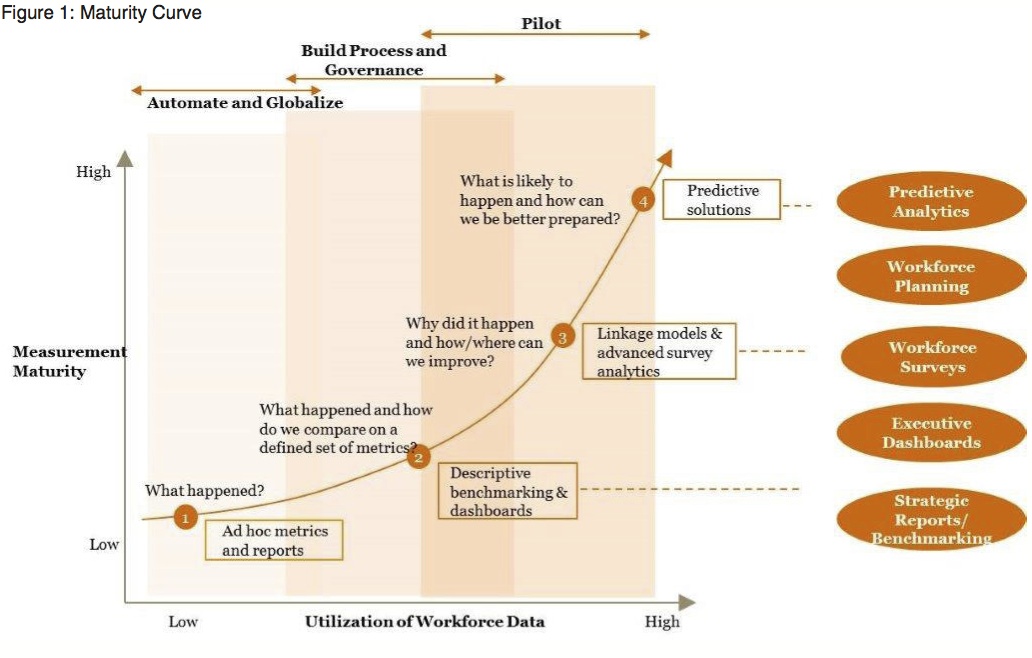
By Ranjan Dutta, Scott Pollak, and Kristina Dunphy
Market demand for workforce analytics is on the rise as business leaders increasingly recognize that the right talent is critical to bringing business strategies to life. Equally important is the ability to access and analyze the right information to support talent-related business decisions. This is often easier said than done.
Many HR departments are beginning to recognize that delivering the right insights at the right time requires the creation of a new competency -one that incorporates the development of new workforce analytics deliverables. In order for an organization to produce these deliverables, they will need to have the tools and technology to create them and an approach to boost usage and adoption.
PwC Saratoga recently published hundreds of metrics that reinforce the business improvement opportunity available to HR departments today -if they can align workforce performance to business strategy, supported by effective data.
Analysis of critical metrics reveals weaknesses in the market, and identifies leading practices in workforce analytics that can help promote better performance. Four areas have strategic significance:
1. Capturing return on workforce investment through operational workforce planning. According to the PwC Saratoga report, productivity indicators trended up in 2013 for a second consecutive year across the 12 industry sectors studied. Revenue per full-time employee increased from $370,399 to $404,058. However, despite improvements, a primary metric for return on workforce Investment -labor cost as a percent of revenue -still remains poor compared to pre-recession levels. To help companies align workforce performance, we take a look at opportunities in workforce planning.
This planning focuses on the here and now, pertaining to next month, next quarter, and the remainder of the year. It can have an immediate impact on labor costs, productivity, and financial results, yielding an opportunity to better align the processes related to labor cost, among them:
- Financial forecasts
- Headcount management
- The talent acquisition pipeline
Operational workforce planning often requires several steps. Companies need the ability to automate the integration of disparate data, including labor costs like compensation and benefits, hiring, revenue, and headcount among others. It also requires breaking down and reforming existing processes like financial forecasting, headcount management, talent acquisition process -those processes that should “talk” to one another but don’t. A champion who recognizes the hidden opportunity that sits within most departments’ estimated budgets for labor spend -like better alignment and lower hiring costs through more planned recruitment -will help operational workforce planning to be executed effectively.
Companies that can better align forecasted headcount and labor cost with projected headcount and labor cost can more easily achieve financial results without creating downstream consequences such as severance, shortages, and poor quality hires. (Forecasted headcount typically stems from previous patterns whereas projected headshot is rooted in actual, current business circumstances like a lost project, a large sale, or lost revenue for an unexpected deal that didn’t happen.)
Much focus in the analytics market has been placed on strategic workforce planning: looking ahead three to five years to determine the gap between the future demand for talent and the future supply. But a more tactical, immediate view related to operational workforce planning can have a great impact as well.
2. Curtailing high-potential and high-performer turnover through an integrated approach to employee surveys. Voluntary turnover has continued to rise consistently across the 12 industry sectors examined, increasing from 8.4 percent in 2012 to 8.8 percent in 2013. Significantly, the separation rate among high performers rose by 19.5 percent, leaping from 5.0 percent in 2012 to 6.0 percent in 2013 -hitting its highest level in a decade.
The trends in turnover metrics demonstrate the importance of promoting employee engagement as a critical program. While the concept of tracking employee engagement has been in practice for several years, many organizations have fallen into a routine of conducting annual surveys without taking into account several factors:
- Action planning;
- Linkage analysis;
- Strategic, programmatic survey management; or
- The practice of using responses as critical inputs to predictive solutions.
Employee surveys are typically siloed and do not align with onboarding or exit surveys, mainly because they are often handled by different parts of HR. Organizations need to recognize the increased value they can achieve by creating a company-wide “integrated” approach to workforce surveys, supported by individuals with the right expertise and insight to improve program consistency and effectiveness.
Organizations can derive insight from a wide array of survey sources across the organization, including recruiting (candidates and hiring managers), onboarding, engagement, exit, and customer (internal and external). Surveys capture current employee attitudes and are good predictors of actual behavior (performance, attrition). But when conducted in isolation, theses practices can fall short.
Including engagement scores into dashboards, strategic reports, and predictive models can raise awareness, accountability, and, ultimately, action planning across the business.
Organizations with mature survey programs may also link individual or corporate engagement results to performance metrics, including review ratings, safety incidents, customer satisfaction, and sales, to determine the business impact associated with improving engagement.
3. Improving new hire quality with a predictive model for selection. The survey results shows two significant hiring trends. First, organizations are hiring more people. Our study shows that the percentage of employee headcount for new external hires has grown in the last three years, increasing by nearly 39.8 percent, from 2010 to 2013. Also, first year of service turnover has increased for the second consecutive year, from 22.6 percent in 2012 to 24.1 percent in 2013.
So, while hiring quantity has increased, hire quality has dropped. Given these trends, it’s reasonable to consider that organizations may relapse to pre-recession talent acquisition approaches, which led U.S. organizations to lose nearly one in three employees within the first year of service.
This begs these questions:
- How do you strengthen your hiring process in the next two to three years in a post-recessionary environment?
- Can we identify those markers of talent acquisition success based on who historically succeeded and those who did not?
- Can we then devise a process to systematically prioritize those characteristics while evaluating job candidates?
We see leading organizations using predictive analytics in their candidate selection process, using advanced analytics to isolate characteristics of success, then using those markers to create strong hiring profiles, and, finally, tailoring assessment surveys that evaluate every potential job candidate for those characteristics. These are typically a combination of attitudinal, demographic, and experiential factors. It’s important to note that even if these assessment instruments have common factors across employee roles, success factors are tied to specific roles.
By gaining a better understanding of the characteristics of successful employees HR departments can recognize which candidates possess the traits and talent that truly aligns with the organization’s culture and needs.
4. Enhancing the strategic role of HR business partners through the use of standardized strategic reports. As the economy continues to revive and the emphasis on talent returns, organizations continue to evolve the HR function amid a growing recognition that HR needs to be more strategic. As this shift continues, overall HR spend continues to grow from $1,923 per employee in 2012 to $1,995 per employee in 2013. Companies are demonstrating that an improved return on workforce investment requires an increased investment in HR.
As part of this transformation, the business partner needs to be transitioned from transactional activities to talent strategy, succession planning, workforce analytics, and the like. As HR business partners become more quantitatively savvy and business leaders demand more frequent and robust HR data, strategic workforce reports are becoming more of an imperative.
Organizations are best served by forming a set of strategic report templates, which can be centered on a variety of workforce themes, including headcount, recruiting, diversity, and performance. Reports can have a balanced view of raw data (employee counts and costs), calculated metrics (turnover rates), internal and external benchmarks, targets, historical trends, and future projections for quick views of improvements and declines, and warning areas that require immediate action.
While business partners and analysts may need to build skills to properly create and leverage these reports, organizations maturing in analytics are investing in these activities now to realize the future payoff.
Harnessing Data: Marching Up the Maturity Curve
The power of workforce data drawn from metrics, surveys, and predictive analytics can help HR drill deep into the nature of the organization’s talent pool and yield answers to support and sustain a talent strategy aligned with business goals. These analytics can help deliver on the promise of the right workforce, the right hires, limited turnover, a robust talent pipeline, an engaged talent team, and the achievement of financial and operational goals.
This is a multi-step undertaking that requires progression along the maturity curve (shown in Figure 1), as well as the creation of a roadmap for implementation, with this question in mind:
What do you need to do with respect to people, technology, and processes to move from the entity’s current position to its desired state?
Most companies need to address activities on two fronts:
- Develop a strategy and roadmap for workforce analytics that assess current state, develops a vision for the future state, defines the recommended approach, achieves alignment among stakeholders, and sells the business case.
- Develop a series of pilots for various workforce analytics programs to better define stakeholder requirements, establish value, and determine the approach to adoption, whether the programs are strategic reports, executive dashboards, workforce plans, or predictive models.
Those companies that tap into analytics can unlock their investment in HR data -and find the hidden value in their workforce. These intangibles can be made tangible on the P&L and on the balance sheet.
Ranjan Dutta is a director in PricewaterhouseCoopers Saratoga, a PricewaterhouseCoopers Human Resource Services practice. Scott Pollak is a principal and Kristina Dunphy is a senior associate for the firm.















